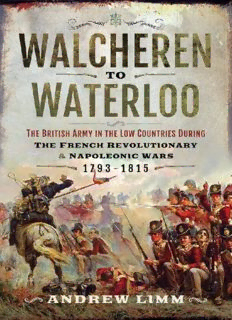
Walcheren to Waterloo: The British Army in the Low Countries during French Revolutionary and Napoleonic Wars 1793-1815 PDF
Preview Walcheren to Waterloo: The British Army in the Low Countries during French Revolutionary and Napoleonic Wars 1793-1815
Walcheren to Waterloo Walcheren to Waterloo The British Army in the Low Countries during the French Revolutionary and Napoleonic Wars 1793–1815 Andrew Limm Contents Acknowledgements Abbreviations Maps Introduction Historiography The Transformation of the British Army, 1795 to 1815? Definition of Terms Methodology and Structure Source Materials 1. The British Army and the Dunkirk Campaign, 1793 The Ministers and the Military The British Army on the Eve of War Reasons for British Intervention in the Low Countries Strategic Planning Process The 1793 Campaign and the Road to Dunkirk Planning and Preparation Aftermath 2. British Defeat in the Netherlands, 1794–5 and the Duke of York’s Reforms Scratching the Surface: York’s Reforms and the British Army The Main Reforms and Their Impact The Training of the Infantry The Reform and the Officer Corps Officer Education The British Approach to Military Education in a European Context The European Military World and the British Army 3. The Expedition to the Helder, 1799 Rationale for Intervention The British Army: Fit For Service? Planning and Preparation Execution Breakout Aftermath 4. The Expedition to the Scheldt, 1809 The British Army: Fit for Service? Rationale for British Intervention Planning and Preparation Execution A Ruinous Seige: The Siege of Flushing ‘Wasting Fever’ The Scheldt Inquiry: Lessons Unidentified 5. The British Army and the Debacle at Bergen-Op-Zoom, 1813–14 British Strategy, the European Powers and the Invasion of France in 1813–14 Rationale for British Intervention in 1813 The British Army: Fit for Service? Planning and Preparation The Hill Upon the Zoom Aftermath Conclusion The Wellington Factor: The Iron Duke, Waterloo and Reasons for British victory Notes Bibliography Acknowledgements This book is dedicated to my wife Reena whose love and support has been instrumental in the completion of this study. I would like to thank my parents, Peter and Catharine, for their encouragement and guidance. My thanks must also go to Professor Michael Snape, Professor Jeremy Black, Professor Bruce Collins, Professor Gary Sheffield, Dr Daniel Whittingham, Dr Armin Grünbacher and Dr Huw Davies for their valuable insights during my research. Finally, I would like to thank the editorial team at Pen & Sword for their efforts in seeing the book through to publication. Andrew Limm, May 2018 Abbreviations AG Adjutant General AHR American Historical Review BCMH British Commission for Military History BMJ British Medical Journal C-in-C Commander-in-Chief EHR English Historical Review EJIR European Journal of International Relations HJ The Historical Journal HLQ Huntington Library Quarterly IHR International History Review JBS Quarterly Journal of British Studies JCH Journal of Contemporary History JMH Journal of Modern History JMHS Journal of Military History Society JSAHR Journal of the Society for Army Historical Research JSS Journal of Strategic Studies MPH War Office Maps and Plans extracted to flat storage PP Parliamentary Papers RUSI Royal United Service Institute Journal QMG Quartermaster General WMQ William and Mary Quarterly Maps
Description: